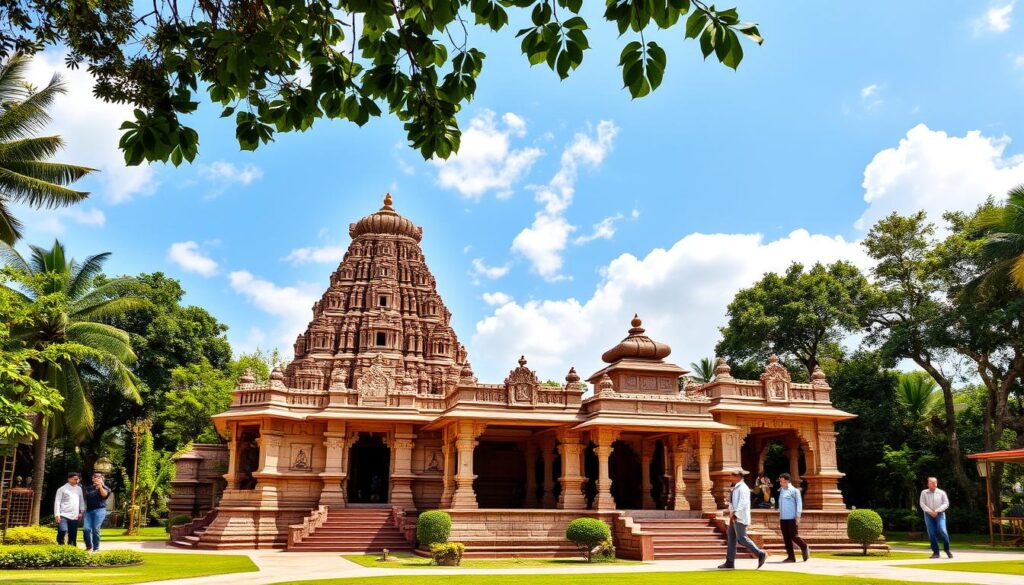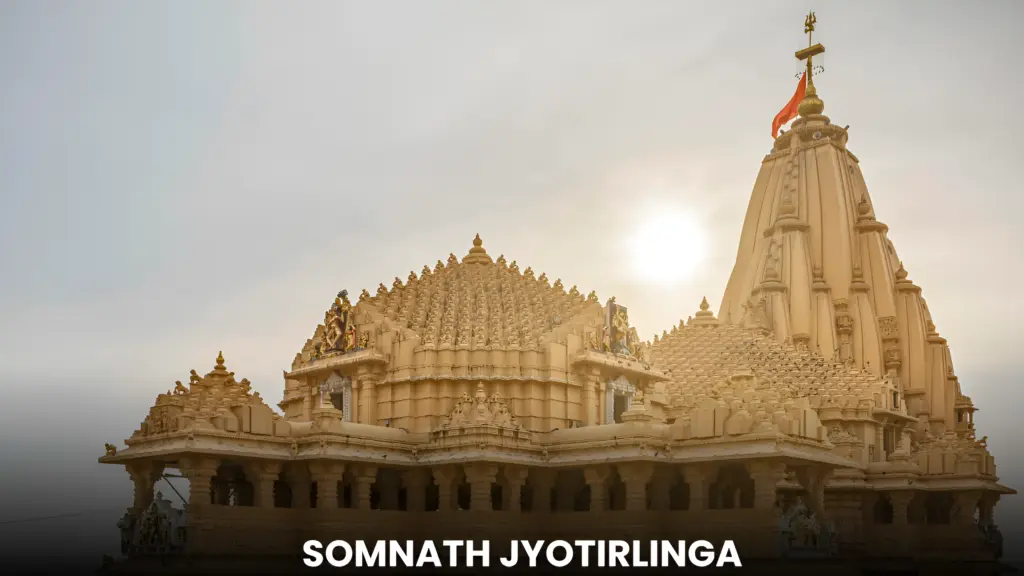The Somnath Jyotirlinga is in Gujarat, India. It’s one of the 12 Jyotirlingas, with a history before the Christian era. This temple is the most sacred, deeply rooted in Hinduism.
The temple has been destroyed and rebuilt many times. The current structure was finished in 1950 by The Somnath Trust. This makes it a key fact about Lord Shiva’s temples.
The Somnath Jyotirlinga is in Veraval, Gujarat. It’s a big pilgrimage site. Its coordinates are 20°53′16.9″N 70°24′5.0″E.
The temple’s history shows its lasting importance. It was built from 1947 to 1951 by Sardar Vallabhai Patel. Ancient texts like the Skanda Purana and Rig Veda mention it, showing its significance.
The Somnath Jyotirlinga’s location is special. There’s no land straight south of it until Antarctica, since 7 AD. This makes it a fascinating place to visit, rich in history and culture.
The Sacred Origins of Somnath Jyotirlinga
The story of Somnath Jyotirlinga is full of myths and legends. It’s linked to the Moon God and Lord Shiva, as the Shiva Purana tells us. This temple is the first Jyotirlinga, a key place for Hindu pilgrims.
The tales of Somnath Jyotirlinga are deep in Hindu myths. The Mahabharat and Bhagavata Purana tell its story. It’s said the Moon God built it with gold, silver, and sandalwood in different times.
The Legend of Moon God and Lord Shiva
Chandra, the moon god, is tied to the temple because of a curse. He is known as Somnath or Lord of the Moon. This shows how important Somnath Jyotirlinga is in Hindu myths.
Significance of the First Jyotirlinga

The stories of Somnath Jyotirlinga make it the first Jyotirlinga. It’s a place of deep spiritual value. Its link to the Moon God and Lord Shiva adds to its historical value in Hindu myths.
Ancient Sanskrit References
Old Sanskrit texts like the Mahabharat and Bhagavata Purana talk about Somnath. They show its big role in Hindu myths. These texts prove Somnath Jyotirlinga’s lasting effect on Hindu culture.
| Temple Era | Builder | Material |
|---|---|---|
| Satya Yuga | Moon God | Gold |
| Treta Yuga | Ravana | Silver |
| Dvapara Yuga | Lord Krishna | Sandalwood |
Understanding the Spiritual Significance of Somnath Temple
The somnath temple holds deep spiritual meaning in Hindu mythology. It is a place of great reverence for many. Lord Shiva is worshipped here as the destroyer of evil.
The temple’s spiritual value is clear. It is the first of the 12 Jyotirlingas. It offers spiritual growth, liberation, and purification to visitors.
People believe visiting the temple can wash away past sins. The temple’s energy is strong. It’s not just for spiritual growth.
It also stands for the cosmic pillar of energy. It brings harmony and purifies the surroundings. The somnath temple is a key spot for those seeking spiritual enlightenment and a connection with Lord Shiva.
The temple’s architecture is unique. It shows a mix of Chalukya, Rajput, and Solanki styles. It has special spots like the Nandi Mandapa and Sabha Mandap.
The temple’s beauty and the chance to join in rituals add to its spiritual value. You can watch the daily aarti and join in festival celebrations.
Architectural Evolution Through Centuries
The somnath temple’s architecture shows its rich history and cultural importance. Its design has changed over time, due to its destruction and rebuilding. This has shaped the temple’s look.
The temple’s first build is a myth, but it’s said to be made of gold by the Moon God. Later, Ravana built it in silver, Krishna in wood, and Bhimdev in stone. Many architectural styles, like Jain and Rajputi, have influenced its design.
Reconstructions and Restorations
The temple has been destroyed and rebuilt seven times. Mahmud Ghazni destroyed it in AD 1024. Then, Solanki King Bhim Dev rebuilt it in wood between AD 1026-1042.
In AD 1296, Sultan Allauddin Khilji’s army destroyed it again. But Mahipal Deva, the Chaudasama King of Saurashtra, rebuilt it in AD 1308.
Modern Architectural Features
The current temple was built in the Chalukya style and finished in May 1951. Its shikhara is about 155 ft tall, with a 10-ton kalash on top. It has three entrances and stands on 64 carved pillars.
The dome over the Sabha Mandap is the biggest in India.
Somnath Jyotirlinga History: From Ancient Times to Present Day
The somnath jyotirlinga history shows the temple’s lasting importance in Hinduism. It has survived many attacks and rebuilds. For example, Mahmud of Ghazni raided it in 1026 CE, causing a lot of damage and theft.
The temple is one of the twelve Jyotirlingas in India. Each is thought to have great spiritual power. Many Hindu rulers and kings have rebuilt it, showing the strength of Hindu faith and the dedication of its followers.
- Located in Gujarat, the temple is a major pilgrimage site, attracting devotees from across the country.
- The temple’s architectural significance lies in its intricate carvings, majestic spire, and its location near the Arabian Sea.
- The latest rebuilding of the Somnath temple was completed in 1947 under the initiative of Sardar Vallabhbhai Patel.
The somnath jyotirlinga history is long and complex, covering many centuries and dynasties. From its ancient beginnings to today, it remains a beacon of spiritual and cultural importance for millions.
Legendary Tales and Mythological Connections
The Somnath Jyotirlinga is filled with rich stories. Many legends and tales surround its creation and importance. One famous story is about Chandra Dev, who built the temple in gold.
This myth shows the Somnath Jyotirlinga’s sacred status. It draws people from all over the world.
The somnath jyotirlinga’s stories are deeply rooted in Hindu myths. Lord Shiva’s tales are central to these stories. The temple is also linked to Krishna’s last journey.
These stories make the Somnath Jyotirlinga very popular. It’s a key place for devotees and those seeking spiritual growth.
- Chandra Dev built the temple in gold to make amends for his wrongdoings.
- The site is connected to Krishna’s final journey, adding to its spiritual value.
- Many legends and stories surround the temple, passed down through generations.
These stories have made the Somnath Jyotirlinga a sacred place in Hindu mythology. It’s a revered site for lord shiva stories and worship.
Archaeological Discoveries and Historical Evidence
The somnath temple’s digs have shown its deep history. Excavations found the temple was rebuilt many times. The oldest part dates back to the 9th century.
These digs also found materials like gold, silver, wood, and stone. These items back up old stories about the temple. Like the Moon God’s story of setting up a Jyotirlingam here to break a curse.
Some key facts about the somnath temple archaeological discoveries include:
- The temple was rebuilt at least six times before the current version.
- The latest rebuilding of the Somnath temple took place in 1947 under the leadership of Sardar Vallabhbhai Patel.
- The present-day Somnath temple was inaugurated on May 11th, 1950, by the then-president of India, Rajendra Prasad.
The somnath temple’s digs and history show its big importance. Its changing looks and ties to history make it special and sacred.
The Temple’s Role in Indian Cultural Heritage
The Somnath Temple is a big part of India’s culture. It has a long history and is very spiritual. Its design shows the many cultures of India.
This temple is one of the twelve Jyotirlingas for Lord Shiva. It shows India’s rich culture.
Millions visit the temple every year. It’s not just a spiritual place. It’s also famous in old stories and history books.
The temple’s design, art, and stories make it special. It’s a place of wonder and learning.
Literary References in Ancient Texts
The Somnath Temple is in old stories like the Mahabharata and Puranas. These stories tell us about its history and importance. They show its big role in Indian culture.
Historical Documentation
The temple’s history is well-documented. We know about its building, destruction, and rebuilding. This history shows its deep cultural value.
Its past is full of stories. It shows India’s complex cultural journey.
Cultural Impact Through Ages
The temple has deeply influenced culture over time. Its design, art, and stories show India’s many cultures. It still inspires and amazes people today.
| Cultural Aspect | Significance |
|---|---|
| Literary References | Provides insights into the temple’s history and cultural significance |
| Historical Documentation | Provides a fascinating glimpse into the temple’s past |
| Cultural Impact | Reflects the country’s diverse cultural influences and continues to inspire people |
Sacred Rituals and Worship Practices
The Somnath Temple is famous for its rituals. These are key parts of Hindu worship. The day starts with the Mangla Aarti at 4:00 AM.
Then, the Shiva Linga is bathed with milk, curd, honey, and ghee. This happens many times a day.
The temple’s worship is deeply rooted in tradition. It’s a big part of the temple’s spiritual value. Some important daily ceremonies are:
- Mangla Aarti: 4:00 AM
- Abhishekam: multiple times a day
- Sandhya Aarti: 7:00 PM
The temple also celebrates big festivals like Maha Shivratri and Kartik Purnima. These are celebrated with great joy. It’s a major place for Hindu worship.
Understanding the Temple Complex Layout
The somnath temple complex is a work of art. It shows off detailed designs and sculptures. The layout of the somnath jyotirlinga temple is meant to be peaceful and spiritual. It’s surrounded by lovely gardens and a view of the Arabian Sea.
The complex is big, with the main temple, shrines, and more. The architecture mixes old and new styles. It has detailed carvings and sculptures on the walls and ceilings. The layout is peaceful, with nice gardens and views.
- Intricate carvings and sculptures
- Beautifully maintained gardens
- Stunning view of the Arabian Sea
- Traditional and modern temple architecture
The somnath temple complex is a place you must see. It’s great for those who love temple architecture and spiritual places. The somnath jyotirlinga temple layout is peaceful. It’s perfect for both devotees and tourists.
| Feature | Description |
|---|---|
| Temple Architecture | Blend of traditional and modern styles |
| Gardens | Beautifully maintained |
| View | Stunning view of the Arabian Sea |
Notable Features and Sacred Spots
The Somnath Jyotirlinga is a very special place. It draws millions of people each year. It’s known for its mix of history, culture, and spirituality.
The Main Sanctum
The main part of the temple holds the sacred jyotirlinga. It’s a sign of Lord Shiva’s power. The area is filled with detailed carvings and sculptures.
Surrounding Shrines
The temple has many shrines around it. Each one is for a different god. They show the area’s rich culture.
Architectural Highlights
The temple’s design is a mix of old and new. It has beautiful carvings, sculptures, and decorations. Its design makes it a unique place to visit.
Some key features of the temple are:
- Intricate carvings and sculptures
- Ornate decorations and traditional architecture
- Surrounding shrines and sacred spots
Planning Your Spiritual Journey to Somnath
A visit to the Somnath temple is a big deal for many. Planning your trip to Somnath needs thought. The best time to go is from October to March. The weather is nice then.
This time is perfect for a pilgrimage to Somnath. You can easily see the temple and around it.
When planning your trip, think about a few things. Consider when to go, what rituals to do, and where to stay. Somnath has many places to stay, like hotels and guesthouses. They fit different budgets and likes.
To enjoy your pilgrimage, follow important rituals and customs. Join in daily ceremonies and special festivals. Also, check out places like Triveni Sangam and Bhalka Tirtha. They add to your spiritual trip.
For a smooth visit, plan early. Book your stay and travel in advance. Buses and private services go to Somnath from nearby places. With good planning, your trip to Somnath will be special and fulfilling.
Conservation Efforts and Modern Development
The Somnath Temple is one of the twelve Jyotirlinga shrines for Lord Shiva. It has seen many destructions and rebuilds. Today, efforts focus on keeping its culture and history alive.
Modern changes have made the temple better for visitors. This includes new amenities and green projects. The Trust has planted 5,500 Bilva trees and other plants. This makes the temple area look beautiful.
They also worked with the state forest department. Together, they planted thousands of plants. This helps the temple and the environment.
Some important projects include:
- Establishment of Shree Somnath Sanskrit University
- Proposal for a new interpretation center
- Environmental development efforts, such as planting trees and promoting sustainable practices
The temple’s history and culture are kept safe. At the same time, new things make it better for everyone. About 50,000 to 60,000 people visit every day. This helps the local economy and improves the area.
Experiencing the Divine Legacy at Somnath Today
When you enter the Somnath Jyotirlinga Temple, you feel a deep spiritual connection. This place has a long history of devotion. It attracts people from everywhere, showing the somnath temple experience.
The temple is alive with spiritual experience at somnath. Millions come every year. The aarti chants, beautiful architecture, and the feeling of reverence are all powerful. It’s a place where you can find peace or join in the joy of festivals like Mahashivratri.
The Shree Somnath Trust helps keep the temple’s culture alive. It offers things like the Light and Sound Show and good facilities for visitors. The Somnath experience touches your heart and mind deeply.
FAQ
Q: What is the history of the Somnath Jyotirlinga?
A: The Somnath Jyotirlinga has a long history. It dates back to ancient times. The temple has been destroyed and rebuilt many times.
Q: What is the sacred origin of the Somnath Jyotirlinga?
A: Hindu mythology says Lord Shiva created the Somnath Jyotirlinga. It’s the first of the twelve Jyotirlingas. It’s very important in Hinduism.
Q: What is the spiritual significance of the Somnath Temple?
A: The Somnath Temple is very sacred in Hinduism. It’s a key place for worshiping Lord Shiva. The temple’s spiritual value is deep in Hindu faith and traditions.
Q: How has the Somnath Temple’s architecture evolved over time?
A: The Somnath Temple has changed a lot over the years. It has been rebuilt and restored many times. This has made its architecture unique.
Q: What is the comprehensive history of the Somnath Jyotirlinga?
A: The Somnath Jyotirlinga has a rich history. It goes back to ancient times. The temple has been important in Hindu history and culture for centuries.
Q: What are the legendary tales and mythological connections associated with the Somnath Jyotirlinga?
A: The Somnath Jyotirlinga has many stories and myths. These include tales of the Moon God and Lord Shiva. It’s also connected to Krishna’s final journey.
Q: What archaeological discoveries and historical evidence support the significance of the Somnath Jyotirlinga?
A: Archaeology and history show the Somnath Jyotirlinga’s ancient roots. They prove its cultural importance in Indian history.
Q: How has the Somnath Jyotirlinga impacted Indian cultural heritage?
A: The Somnath Jyotirlinga has deeply influenced Indian culture. It’s mentioned in ancient texts. It has a long history of cultural significance.
Q: What are the sacred rituals and worship practices associated with the Somnath Jyotirlinga?
A: The Somnath Temple is known for its rituals and worship. Daily ceremonies and festivals are part of Hindu tradition.
Q: Can you describe the layout and architectural features of the Somnath Temple complex?
A: The Somnath Temple complex is a stunning example of Hindu architecture. It has a main sanctum, shrines, and other notable features.
Q: What are the notable features and sacred spots associated with the Somnath Jyotirlinga?
A: The Somnath Jyotirlinga has many sacred spots and features. These include the main sanctum, shrines, and architectural highlights.
Q: How can one plan a spiritual journey to the Somnath Jyotirlinga?
A: Planning a trip to the Somnath Jyotirlinga involves choosing the best time to visit. You should also observe rituals and arrange accommodation for a meaningful experience.
Q: What conservation efforts and modern developments have impacted the Somnath Jyotirlinga?
A: Conservation and modern developments have helped preserve the Somnath Jyotirlinga. They ensure its significance today.
Q: What is the modern-day experience of visiting the Somnath Jyotirlinga?
A: Visiting the Somnath Jyotirlinga today is a unique experience. It lets visitors connect with the temple’s history, architecture, and cultural legacy.


